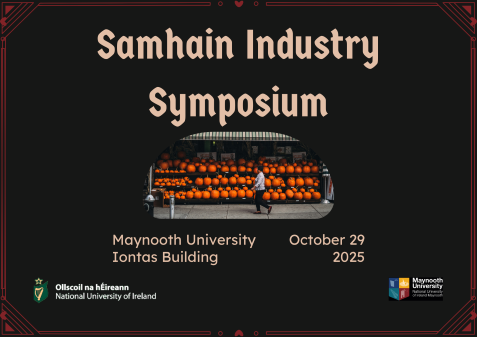
Report by our Alumna Dr Lucy Moreau reports on her attendance at Maynooth University's interdisciplinary symposium "Samhain, Halloween and Irish Industries".
This Wednesday, I was one of the speakers at Maynooth University's interdisciplinary symposium, Samhain, Halloween and Irish Industries. The day-long event brought together scholars to examine a pressing cultural question: As Ireland invests €2.1 million to position itself as the ‘Home of Halloween’ through the new destination development scheme, what happens to the relationship between cultural tradition and commercial value?
The symposium's core concern resonated with broader debates about Irish identity and heritage. Just as St. Patrick's Day arguably lost cultural significance through twentieth-century commercialisation before being reclaimed in the 1990s, Halloween faces similar tensions. The festival originated in Ireland as Samhain, was suppressed during colonial rule, travelled with emigrants to America where it became commercialised, and has now returned to Ireland through American media—creating a double displacement. The government's investment scheme projects €28 million in economic impact for local communities, with overseas visitors potentially contributing €60 million annually. These figures raise important questions about how we value and preserve cultural traditions in contemporary Ireland.
My presentation, From Púca to Paddock: Horses as Hidden Codes for Irish Mythology in Anglo-Irish Literature, explored how Irish writers preserved Celtic supernatural traditions during colonial rule through strategic encoding. The púca—the shape-shifting entity from Irish folklore that most commonly appears as a dark horse—became a vessel through which writers like Joyce, Yeats, and Lady Gregory transmitted mythology within literary forms that seemed designed to exclude it. I argued that when James Joyce used the 1904 Gold Cup in Ulysses, it wasn't mere narrative decoration but structural foundation. Throwaway, the horse who was the 20-1 outsider defeated British establishment favourites and functioned as Joyce's encoded critique of colonial power—resistance hidden within the coloniser's own sporting obsession.
The interdisciplinary nature of the symposium was particularly valuable. Dr. Frederic Armao examined how Samhain persists in Celtic metal culture. Dr. Jenny Butler discussed contemporary Irish pagan practices at Samhain, showing how the festival continues as lived spiritual tradition. Dr. Daithí Kearney explored folk and dance theatre's role in presenting Samhain for contemporary audiences. Dr. Lára Ní Mhaoláin shared material from the Schools' Collection of Irish folklore, including testimony that "there does be spirits out on Halloween night"—evidence of how the tradition persisted in rural communities despite official suppression.
What emerged most clearly from the day's discussions was the complexity of contemporary commodification. The Púca Festival and broader Halloween tourism cannot be dismissed simply as corruption of authentic tradition. Rather it suggests that Irish supernatural traditions have always survived through transformation rather than rigid preservation. The symposium concluded that understanding historical encoding strategies illuminates current debates about commercialisation versus preservation. As Ireland navigates tensions between cultural sovereignty and economic development, between heritage preservation and commercial viability, the púca's historical trajectory offers important insights. The púca survived by shapeshifting—appearing differently in different contexts while retaining essential power. Perhaps contemporary Halloween's commercial transformation represents not tradition's death but its latest metamorphosis?